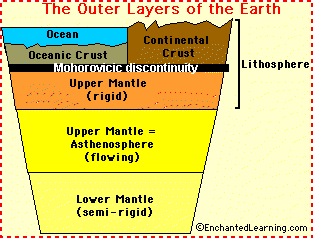On you stand on solid ground the next time give some thought to what geologists theorize is happening under us. Of course theories are based on a lot of collected information and data from years of research and experimentation. With the earth's interior structure much of this information and data is called "second-hand" due to the fact that what they are stating has never been tested or seem directly. So geologists use this information to formulate a theory about what is happening under our feet. A theory is the best explanation for what is happen inside the Earth.
REMEMBER THIS IS THE STUFF THAT THEORIES ARE MADE OF.
NOT ALL GEOLOGISTS AGREE ON THE INFORMATION BELOW.
SOURCES OF INFORMATION MAY NOT BE IN TOTAL AGREEMENT.


(From EnchantedLearning.com)

(From EnchantedLearning.com)
The layers:
1. Lithosphere
a. Crust
i. Continental crust
ii. Oceanic crust
iii. Mohorovicic Discontinuity...marks
the lower boundary of the crust[i]
b. Uppermost solid rock mantle is included in the lithosphere.
2. Asthenosphere...upper mantle which is made up of weaker,
plastics rocks
3. Lower mantle
4. D" layer (dee double prime)[ii]
5. Outer core
6. Inner core
Layer Details
1. Lithosphere:
a. It contains the continental crust. This topmost layer contains the least dense rock.
i. The
thickness of this layer is from 35 km.[iii] The
continental crust will be thicker under mountain ranges sometimes as
thick as 60 km.
ii. This
layer is made of lighter volcanic granitic rock with a density of 2.6 gm/cm3.[iv]
b. On the ocean floors is the oceanic
crust. This volcanic rock is basaltic
and the thickness
averages 5-10 km. This layer has a
higher density about
3 gm/cm3. [v]
3 gm/cm3. [v]
c. This part of the lithosphere is the upper
area of the upper mantle. It is thought to
be solid, rigid and somewhat
cool. Scientists also think the rock to
be even denser.[vi]
d. The entire lithosphere has a thickness of
100 to 20 km.[vii]
[i]
Geology.com
[ii] D’’
Layer Demystified
[iii]
Lithosphere: World of Earth Science
[iv] Structure
of the Earth-HyperPhysics
[v]
Structure of the Earth-HyperPhysics
[vi] Lithosphere:
World of Earth Science
[vii]
Inside the Earth-Enchanted Learning
2. Mohorovicic Discontinuty
a. The word discontinuity
means that at this surface is where the speed of seismic waves
from earthquakes change speed and sometimes direction.
b. This layer
is found 32 km below the surface.[i]
[i]
Geology.com
3. Asthenosphere: Upper Mantle
a. This
layer, which most areas are in solid rock form, also contains regions of hot bendable rock that can
slowly flow. The asthenosphere is found anywhere between
80 to 200 km beneath the surface and can extend up to 700 km down. The
asthenosphere thickness is affected by the b. This means
some regions of hard and rigid rock can become bendable
and plastic-like
as heat and pressure increases in that region
of the asthenosphere.[ii]
c. Since
some regions of the asthenosphere contain hot, slow flowing
rock and this slowly flowing rock is called convection
currents that
circulate between the
outer core and the lithosphere.

(from joidesresolution.org/node/1897)
d. The upper
mantle has a thickness of about 410 km stretching
from the crust down into the Earth's interior.
e. The
transition zone is an area from 410 km to 660 km where there
is no melting of rock, but instead the
rocks undergo changes
in their crystalline structure becoming
a lot denser.[iii] In other words the rock crystals are put
under great heat
and pressure and the crystals
change into new and denser crystals.
4. Lower Mantle:
a. The
composition of the rock in this layer is in dispute among geologists. Some think
the subducted slabs of lithosphere slowly sink into the lower mantle. This means
that they see the rock as hot and bendable.
Others feel that the lower mantle
is not moving nor transferring heat through
the process of convection.[iv]
b. The rock
in this layer is hotter and denser than the layers above it.
c. This
layer is at a depth of 650 to 2890 km.
5. D’’ (Dee double prime)
a. Found a
location from 2,700-2890 km below the earth’s surface and
is often included in the lower
mantle..[v]
b. This
region can be very thin in some places, have large build-ups of
iron and silicates, and even
areas of large melts which maybe form a
mantle plume. [vi]
6. Outer core:
a. Located at
2890 to 5,150 km.
b. This layer
is melted iron with other elements mixed in to make it
less dense than the inner core.
c. Convection
currents move about the outer core created the Earth’s magnetic field.
NOTE: a, b, and c.[vii]
7. Inner core:
a. At a depth of 5,150 to 6,370 km.
b. Thought to be solid iron and nickel.
[i] 10
Facts About Asthenosphere: Fact File
[ii]
10 Facts About Asthenosphere: Fact File
[iii]
The third rock from the sun-restless earth
[iv] The
third rock from the sun-restless earth
[v]
Earth’s Interior & Plate Tectonics
[vi] The
third rock from the sun-restless earth
[vii] Earth’s
Interior and Plate Tectonics
Bibliography:
D'' Layer Demystified
news.sciencemag.org/2004/03/d-layer-demystified
Earth's Interior & Plate Tectonics by Rosanna L. Hamilton
www.if.ufrgs.br/ast/solar/earthint.htm
Inside the Earth-Enchanted Learning
www.enchantedlearning.com/subjects/astronomy/planets/earth/inside.html
Lithosphere-World of Earth Science
www.encyclopedia.com/topic/lithosphere.aspx
Mohorovicic Discontinuity- The Moho
geology.com/articles/mohorovicic-discontinuity.shtml
Structure of the Earth-HyperPhysics
hyperphysics.phy-astr.gsu.edu/hbase/geophys/earthstruct.html
10 Facts About Asthenosphere-Fact File
factfile.org/10facts-about-asthenosphere
The third rock from the sun-restless earth
education.nationalgeographic.com/encyclopedia/media
No comments:
Post a Comment